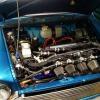Any suggestions are welcome to help me solve this:
After pulling the wiper motor and spiral/toothed cable in order to replace a corroded wiper wheelbox, I lost running-lights/side-lights/dash-lights and dim-dip/low-beams. (unrelated systems I know, but it was the ONLY thing I was working on before losing the lights!)
I run a LHD 1991 Mainstream carb'd Mini Cooper in NYC. Had it about 3.5 years. I have no additional driving lights in place, just the stock headlight housing that has the integrated side-light and the big, round two filament bulb. I believe I have the "Pink dim-dip" relay, although I have never seen it, but I also believe the PO had removed the resistor by the radiator because A) I don't see the resistor, just the socket and B) the low-intensity filament does not light when I turn on the ignition with just the running/side-lights switched on (that is when they used to work :-( ).
First thing to rule out is the main lighting switch:
Approximately 6 months ago I cleaned up the interior of the main lights rocker switch because some melted plastic was preventing the dim-dip/low-beams from illuminating (I'd get sidelights only), but I am confident that it is in proper working order still because I have tested it both with a continuity tester and I have also "flipped it over" in order to plug in JUST the Brown HOT wire lead, exposing the other two pins to test, I looked for 12+Volts to appear on the Red and Blue pins and it performs properly: in position 1 neither Red, nor Blue have power; in position 2 Red goes 12V; and in position 3 Blue AND Red go 12V.
(no need to suggest adding relays, from what I've read on these forums for the past several hours, I've learned that I should definitely be fitting relays on my headlights to prevent further switch melting in future, but for just right now I simply need to get basic headlights back working before this weekend)
Next the fuse box:
First I checked each and every fuse in the fuse box along with the inline fuses behind the carb via continuity tester - all good, none blown.
Then I looked for voltage for the running/side-lights: I do not get 12V on the fuse box at pin 7 (Red side) when the main switch is in positions 2 or 3 so I feel that the problem must be between the leads from the switch in the cabin on their way to the fuse box. And this is just running//side light operation - I'm not even talking about dim-dip/low-beams yet (presumably managed by the Pink Relay) - if the red lead from the main switch is not granting power to the Pink dip-dim relay - could that cause no headlights?
Further testing tells me the running/side-lights loom (after the fuse box) seems OK:
I jumpered my Brown HOT on the fuse box (via an in-line fuse jumper/tester that I fabricated) to fuse box pin pin 8 (the Red/Green side) and the running/slide lights all came on - I get the same results if I feed 12V to the pin 7 (Red side) as long as the fuse is in place, so I believe that the major portion of the loom is OK and the grounds exiting the various running/slide light lamps are sound.
Now the odd stuff you need to know:
About a year ago some rats chewed through a Blue/RED wire on the engine compartment side of the firewall and I lost dim-dip/low-beams. Note that I soldered in a new wire segment in and have had dip-dim/low-beams FINE for all this time. Since this ONLY affected headlights, NOT sidelights too, I discount this as causative this time.
A year before that, I took the Mini to a PepBoys for the annual inspection and they couldn't get the blinkers/directionals/turn-signals to light - I popped the fuse in the box and reseated it and got those back, but I noticed my dash lights and right rear tail light (not brake light) were not illuminated. As a quick fix to drive home I jumpered from the left taillight over to the right and that then illuminated (as did the dash lights). After several repeat events of blinker-loss (which I discovered was also brake-lights-loss and reverse-lights-loss too), I removed the entire fuse box and cleaned it up, testing the fuse box tabs for conductivity because I understand the rivets sometimes fail to conduct from the fuse to the tabs, What I found was corrosion inside the White and Green wires of fuse 2-3 and fixed that - NO issues with blinkers/brakes/reverse-lights since (although I still have that jumper in the boot that was illuminating the dash lights in place).
One other thing that might tie into this problem "timing-wise":
Recently - perhaps coincidentally, I noticed that my high-beam stalk control was no longer locking in the "pushed-away" position. It still would flash when "pulled" and also flashes when pushed now, but it just won't lock "on". Could this be part of my problem? I thought this switch only powered up the high-beams ALONG with the dip-dim/low-beams - am I mistaken - does the stalk in some way "toggle" between the different headlights: pushed=high/centered=low/pulled=flash/high?
And now the super weird bit:
When I gave up trying to track the running/side-lights/dash-lights & dip-dim/low-beam problem down scientifically, I fell back on the "Well, what did you disturb while messing with the wiper repair?" tactic. Over by the motor there was a loom that is moved around a bit, but the loom tape was intact upon inspection and it wasn't really disturbed too much. But over on the left-hand-side where the one corroded wiper wheel box was, I was really moving the foam on the bulkhead down and around a bit to get my hand and a wrench in there. I noticed a rectangular flasher 9FL12V relay nestled in a cutout in the foam there and on a lark I just pushed it down thinking maybe I dislodged it and need to seat it again. VOILA! My running/side lights AND my dip-dim/low-beams miraculously began to work. I couldn't see how a flasher unit would play a part in the main lights circuit, but as it was getting dark and raining by then so I simply I counted myself lucky and headed in for the night.
The following morning my luck had run out as neither my running/side lights nor dip-dim/low-beams worked anymore. Plus, when I pulled that relay out of the foam to get a better look, I found its Purple/Orange terminal had experienced a meltdown. Based on the condition and lack of any smell, it must have happened some long time ago - see pics (note the black thing under the relay is a car alarm horn that has been in place for 3 years - not a likely culprit here)
 9FL12V-PU-O-Connector-melted.jpg 39.92K
2 downloads
9FL12V-PU-O-Connector-melted.jpg 39.92K
2 downloads  9FL12V-old-PU-O-melt-rust.JPG 37.32K
2 downloads
9FL12V-old-PU-O-melt-rust.JPG 37.32K
2 downloadsIt's a wonder that my flashers have been working like a champ. It's possible that I temporarily grounded the P/O lead, but I do not see how grounding that circuit would contribute to the running/side-lights or dip-dim/low-beams circuit spring back to life. I also found it strange that the "out" wire was Green/White instead of Green/Pink stripe like the wiring diagrams call for.
See attached all the wiring diagrams I've been pouring over trying to suss this out - note the "relay" diagram is MY guess at what is going on inside that Pink relay...it could be completely wrong!
 relay.png 201.54K
6 downloads
relay.png 201.54K
6 downloads Indicator-Hazard Wiring MK4.png 75.52K
2 downloads
Indicator-Hazard Wiring MK4.png 75.52K
2 downloads wiring.png 376.78K
3 downloads
wiring.png 376.78K
3 downloads wiring-2.png 406.86K
6 downloads
wiring-2.png 406.86K
6 downloadsI'm pretty much at wit's end here as I'm not sure what to check/test next...
Thanks in advance to anyone who can offer help/suggestions/prayers!
Jim
Edited by [email protected], 04 May 2016 - 02:43 AM.



















